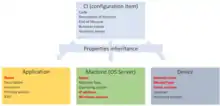Configuration item
The term configuration item (CI) refers to the fundamental structural unit of a configuration management system.[1] Examples of CIs include individual requirements documents, software, models, and plans. The configuration-management system oversees the life of the CIs through a combination of processes and tools by implementing and enabling the fundamental elements of identification, change management, status accounting, and audits. This system aims to avoid the introduction of errors related to lack of testing as well as of incompatibilities with other CIs.
Description
The term "configuration item" can be applied to anything designated for the application of the elements of configuration management and treated as a single entity in the configuration-management system. Configuration items, their versions, and their changes form the basis of any configuration audit.
- The entity must be uniquely identified so that it can be distinguished from all other configuration items.
- From the perspective of the implementer of a change, the CI is the "what" of the change. Altering a specific baseline version of a configuration item creates a new version of the same configuration item, itself a baseline. In examining the effect of a change, two of the questions that must be asked are:
- What configuration items are affected?
- How have the configuration items been affected?
- The use of the CI within a product can be traced in a robust status-accounting system.
- The CI is subject to acceptance verification based on established criteria.
Configuration item types
Examples of CI types are:
- Hardware/Devices
- Software/Applications
- Communications/Networks
- Location
- Database
- Service
- Documentation
- People (Staff and Contractors)
Entities of Change management, Incidents and Problem management and other processes are sometimes also considered a Configuration items.
CI attributes and data
Configuration items are represented by their properties. These properties can be common to all the configuration items (e.g. unique item code that we will generate, description of function, end of the lifecycle or business owner that is approving configuration item changes and technical owner, i.e. administrator, that is supporting it and implementing the changes). Further properties can be specific for the given item type. Hardware devices will have some properties, database servers another and application and certificates again other properties.
Examples of common properties:
- CI Unique Identifier or Identification Code
- CI Name or Label (often, both long names and short names)
- CI Abbreviations or Acronyms
- CI Description
- CI Ownership (organizations and people)
- CI Importance
Identifying properties

Each type of configuration item should have certain properties, combination of which will be unique. Therefore, we will be able to recognize according to them which item we are dealing with. In case of devices such unique combination will be e.g. Manufacturer of the device, Model/Type and Serial number.
Identifying properties (highlighted in red) allow us to distinguish between particular instances of these items.
Releases
A release (itself, a versioned entity) may consist of several configuration items. The set of changes to each configuration item will appear in the release notes, and the notes may contain specific headings for each configuration item. A complex hardware configuration item may have many levels of configuration items beneath its top level; each configuration item level must meet the same fundamental elements of the configuration management system.
Vocabulary
In addition to its purpose in the implementation and management of a change, each configuration item's listing and definition should act as a common vocabulary across all groups connected to the product. One should define the CI at a level such that an individual involved with product marketing and an individual responsible for implementation can agree to a common definition when they use the name of the configuration item. Selection and identification of configuration items for a particular project can be seen as the first step in developing an overall architecture of the product from the top down.
References
-
Compare: Coupland, Martyn (2014). Microsoft System Center Configuration Manager Advanced Deployment. Professional expertise distilled. Packt Publishing Ltd. ISBN 9781782172093. Retrieved 2015-08-03.
Application management in the background is more complex than the way packages execute in Configuration Manager. The process works using Configuration Items (CIs).